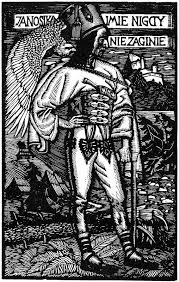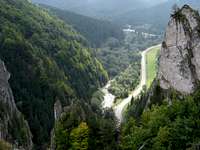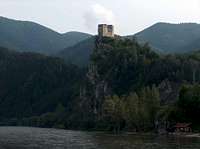EricChu - Apr 21, 2010 2:49 pm - Voted 10/10
A highly interesting article!This is a figure I'm sure not all that many people outside of Poland, Slovakia and the Czech republic know about! Thanks for posting this article which sheds light upon part of the less "celebrated" but nonetheless very turbulent and also very troubled history of this part of Europe!
Many greetings to you,
Eric
sascha - Apr 27, 2010 4:34 am - Hasn't voted
Re: A highly interesting article!I watched the movie about him long time ago, it was probably Poland's 1974 film "Janosik", by Jerzy Passendorfer. Only remember that I was very sad when they executed him. Any way he is known to (little) older generation in Ex Yugoslavian area.
visentin - Apr 27, 2010 5:09 am - Hasn't voted
Re: A highly interesting article!Thanks !
That's interesting and confirms what I read about the Serbian version of Janosik :)
Liba Kopeckova - Apr 24, 2010 9:59 am - Voted 10/10
wow...I would not expect to find a story about Janosik here... Thanks... Yes, we had to study about him in the school, and truly for Czechs and Slovaks (I do not know about Poles) he was regarded as a hero...
visentin - Apr 26, 2010 2:22 am - Hasn't voted
Re: wow...Thanks ;)
Yes, Janosik is interesting not only for the accounts on him, but also the means by which it became so popular. I didn't know such testimony like yours about studying him at school, but I am not surprised, and that's interesting. Janosik is interesting in 50% also for all this sort of things that where made around this character.
yatsek - Apr 30, 2010 3:16 pm - Voted 10/10
Re: wow...Liba,
Can you remember any theories (from school :)) trying to explain why it was actually Janosik who became the "Carpathian Robin Hood"? For example, Dovbush/Dobosz of the Chornohora – unlike Janosik – was very cruel and pretty successful. Shall we say Janosik became a hero since he'd been neither cruel nor successful?
visentin - May 4, 2010 2:47 am - Hasn't voted
Re: ...a very cruel and violent characterYes, George Bush ! :)
visentin - May 18, 2010 2:30 am - Hasn't voted
Re: ...a very cruel and violent characterDespite not being an US citizen I do see the result of his politic, against my willing, in my own country (Calais to be more precise)
Sorry for that but my opinion about him is the same, whatever US citizens think of what he did outside his continent !
visentin - May 4, 2010 2:46 am - Hasn't voted
Re: How many Janosiks?Yes, looks like every country has a Janosik on his own. Indeed, the "kind" Janosik robbing the riches to give the poor seems to be more or less some fable made through the ages (not to say : during socialism ?). Historical accounts describe indeed Janosik as very crual.
yatsek - May 4, 2010 3:05 pm - Voted 10/10
Re: How many Janosiks?I'm not so sure about Janosik being (reported) to be cruel. I bet the Slovak woman who wrote the screenplay for the Holland film will disagree with you.
visentin - May 4, 2010 3:45 pm - Hasn't voted
Re: How many Janosiks?Perhaps you're right.. he was perhaps wandering in the Carpathians only to study architecture and limestone :)
Mountain_girl - May 6, 2010 3:53 pm - Voted 10/10
Great article!I already forgot that we (Eastern Europeans) have this hero :) Thanks for posting. Maybe it would be nice to tell a few more legends... Gosia
JKipple - May 17, 2010 3:25 pm - Voted 6/10
?This is an interesting article, but what is it doing on SummitPost? Aside from operating in a scenic and mountainous region, what does this guy have to do mountaineering? Enjoyed the read, but it seems misplaced.
visentin - May 18, 2010 2:24 am - Hasn't voted
Re: ?In this case what about all etymology articles, legends, stories, and so on. Well, keep doing your mountaineering epics on your side and don't read it if you don't like it !
visentin - May 19, 2010 4:50 am - Hasn't voted
Re: ?and thanks for your 6/10 following my answer, how childlish...
JKipple - May 20, 2010 1:38 am - Voted 6/10
Re: ?Oh please. It's a "fair" article IMO, meaning a score anywhere between 5 and 7. If I really wanted to slam it, do you seriously think I would vote a 6?
Wandering Sole Images - May 23, 2010 10:18 am - Hasn't voted
I agree......that I'm not sure history articles that aren't about the mountains or any outdoor activity should be on Summitpost. But looking at all the positive response, I guess I'm in the minority to feel that way. And since it's on the front page, I guess history is part of Summitpost's desired content.
visentin - May 23, 2010 2:06 pm - Hasn't voted
Re: I agree..."history articles that aren't about the mountains". Obviously you haven't read it. But thanks for the positive feedback.
Petro - May 29, 2010 12:13 pm - Hasn't voted
MisunderstandingsI think the reason of the disagreement about placing this material on Summitpost may be that hiking in Europe is almost inherently bond to some kind of interest in local culture, history, etc. It may be something not so natural for some of the American (not only of course) hikers from the "peakbagging tradition" for whom mountains themselves are the only reason to hike.




























Comments
Post a Comment